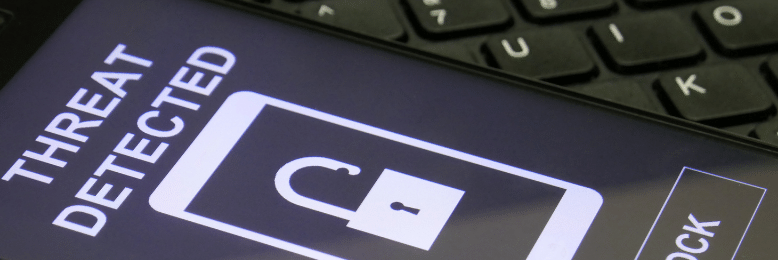How do security experts detect network intrusions?
September 6th, 2021 | 5 min. read

Savvy attackers can breach networks and go undetected for weeks or even months. There could be one lurking right under your nose. Find out how cybersecurity experts detect threats like these and how you can apply them to your business.
Here's an alarming statistic: 60% of small to medium companies fold up within six months after falling victim to a cyber attack.
Do you still think your business is too small to be on the menu for cybercriminals? I have news for you, and it's not a good one.

Hackers developed a taste for small businesses, and the numbers are sobering. According to a survey, 42% of small businesses reported run-ins with some form of ransomware or security threat in 2020. The worst part is that that number is still on the rise.
If that still doesn't alarm you, then think about this: You might have an intruder in your network right now, biding his time, gathering your data, and plotting ways to extort you. Maybe they’re just waiting for the right time to strike, like a holiday or a weekend when your IT department is out of the office, and wouldn’t be able to respond quickly.
In a recent high-profile cyber attack, the victim found evidence the hacker lurked in their email system for nine months. It's one of the worst breaches ever reported in US history.
The one thing you should take away from these facts is that no one is off the menu, and you should be checking your network for intruders constantly.
But don't hit that panic button just yet. Because fortunately, there are things you can do to prevent it from happening to you.
At ITS, we have years of experience helping businesses improve their cybersecurity efforts.
In this article, we'll share how security experts detect intruders in your network and how you can apply it to your organization. To do that, we'll answer the following questions.
- How do security experts detect network intrusion?
- How do experts view cybersecurity?
- What do they use to detect threats?
- What is SIEM?
- What suspicious network activities should you be watching for?
- How can I detect intrusions in my network?
How do security experts detect a network intrusion?

Detecting network intrusions can't be done with a single solution. It's similar to how you would protect your physical office from an intruder. You would want several safety measures in places like biometric door locks, security cameras, and alarm systems.
That's also the way experts secure your network and detect intruders. Simply put, they place multiple monitoring systems in your network then they review the logs for suspicious activity religiously.
In order to better understand how security experts detect threats, it's important to first learn how they view cybersecurity in general.
How do experts view cybersecurity?
.png?width=778&name=cybersecurity%20(2).png) For security experts, there is no single solution when it comes to defending a network. Instead, they prefer building a robust system consisting of multiple overlapping layers. The layers impede an attacker's progress and help improve chances to detect intruders.
For security experts, there is no single solution when it comes to defending a network. Instead, they prefer building a robust system consisting of multiple overlapping layers. The layers impede an attacker's progress and help improve chances to detect intruders.
The overlapping layers can include system-level defenses. These operate in the background and don't disrupt your team's workflow. They include endpoint protection software, antivirus, backups, firewalls, and other systems.
On the other hand, other critical defenses require you and your team's active participation. These include using multi-factor authentication, taking part in cybersecurity awareness training and passing the certification checks, and reporting suspicious or anomalous interactions to IT or compliance personnel.
For experts, this multi-layered strategy constitutes the baseline security measure that all businesses should have. This baseline not only helps IT practitioners prevent and respond to threats it also widens their scope of influence when a breach occurs.
What do they use to detect threats?
Once all security layers are in place, a security expert will then have the tools he needs to deploy Security Information and Event Management (SIEM) processes.
What is SIEM?
SIEM is data ingestion and analytics platform that allows security analysts, compliance officers, and other IT roles to gain control of the thousands or millions of system events generated by a broad IT ecosystem on any given day. Simply put, it gathers IT logs from your entire network and compiles them so you can better make sense of the information.
How does SIEM work?
It monitors your entire network through all the defensive layers you have in place. Security experts can then proceed to look for and flag any suspicious activity.
In other words, it's like an alarm system for your network that lets you know when someone has broken in and how they did it. Ideally, your team will be able to catch suspicious network activity early before any harm is done. But if you’re unable to do so, it can also help you investigate how to prevent it from happening again.
What suspicious network activities should you be watching for?
Recognizing suspicious network activity is vital in helping security experts determine the source and the nature of a breach. It gives them the upper hand, enabling them to react quickly and patch the breach to minimize damage.
Take a look at some common examples of activities that might indicate your network is compromised:
- Abnormal database activity
- What to watch out for: changes in your users and/or permissions and abnormal data content growth.
- Account abuse
- What to watch out for: modified audit trails, sharing account access and credentials, accessing sensitive data unnecessarily.
- User access
- What to watch out for: changes in user access, including accessing data at odd hours, accessing info remotely, multiple failed login attempts, and other similar discrepancies.
- Strange network behavior
- What to watch out for: protocol violations, unauthorized scans, odd network traffic, and sudden unexplainable changes in network performance.
- Unauthorized port access
- What to watch out for: unauthorized port access can signify a malware attack.
How can I detect intrusions in my network?
 Now that you know the basic strategies and methods employed by experts, we'll now delve into how you can implement them for your business. Unfortunately, there is no easy way to do that. If there was, cybercrime statistics wouldn't be nearly as high as it currently is.
Now that you know the basic strategies and methods employed by experts, we'll now delve into how you can implement them for your business. Unfortunately, there is no easy way to do that. If there was, cybercrime statistics wouldn't be nearly as high as it currently is.
However, it doesn't mean you're completely helpless. These are just some of the things that you can do to better protect your network and detect unwanted guests.
Adopt an assume-breach mindset
We've already established that savvy attackers can breach networks and go undetected for weeks or even months. They will always find new ways to penetrate security systems, steal data or extort you. That's why if there was ever a place for pessimism in the workplace, it's with regards to your cybersecurity.
An assume-breach mindset is a pessimistic approach to securing your network. You need to assume that a breach will occur or is already occurring. This simple shift in mindset can help you transition from a passive defense strategy to a more proactive one. It pushes you and your team to cultivate your defenses and continuously monitor your network for threats and vulnerabilities.
Invest in cybersecurity solutions
If you're still wondering when you should begin investing in cybersecurity, there's no better time than now. Like we said before, small businesses are beginning to look like ripe targets for cybercriminals.
Consider investing in cybersecurity tools and cyber insurance. These are all vital in helping ensure your business can either prevent an attack or survive one.
You might have budget concerns now, but there are ways to implement cybersecurity even when you're on a tight budget. Also, you don't need to have a comprehensive system all in one go. You can build your defenses slowly and save up for a more robust solution in the future.
Open the lines of communication with your team
Your team is often your network's first line of defense. The fact is, no matter how sophisticated your cybersecurity tools are, they will fail if your team doesn't know how to identify and respond to cyber threats.
A single user who succumbs to a spear-phishing email or social engineering phone call might go unnoticed by the system-level protections, yet the damage could be catastrophic. Initiating cybersecurity awareness training programs to help teach your team how to handle these situations is vital.
Communicate with your team regularly and let them know they have a role to play in securing your network. The simple act of reporting suspicious or anomalous interactions or even just admitting to clicking on a malicious link can help buy you precious time to detect the breach and minimize the damage.
Ready to secure your network from intruders?
Threats are always present, so it's safe to assume that your business could be a target. With that in mind, you can never go wrong in improving your cybersecurity efforts.
We at ITS have spent years helping businesses prevent and recover from cyberattacks, and based on our experience, clients who had the best outcomes prepared for the worst before an attack even occurred.
Want to get started on bolstering your security efforts? Find out the top 15 cybersecurity practices you should implement.
Mark Sheldon Villanueva has over a decade of experience creating engaging content for companies based in Asia, Australia and North America. He has produced all manner of creative content for small local businesses and large multinational corporations that span a wide variety of industries. Mark also used to work as a content team leader for an award-winning digital marketing agency based in Singapore.
Topics:
